

Crocodile attacks on humans are common in places where large crocodilians are native and human populations live. It has been estimated that about 1,000 people are killed by crocodilians each year. [1]


Crocodile attacks on humans are common in places where large crocodilians are native and human populations live. It has been estimated that about 1,000 people are killed by crocodilians each year. [1]

The two species with the most well-known and documented reputation for preying on humans are the Nile crocodile and saltwater crocodile, and these are the perpetrators of the vast majority of both fatal and non-fatal crocodilian attacks. [1] Each year, hundreds of deadly attacks are attributed to the Nile crocodile in Sub-Saharan Africa. Attacks by saltwater crocodiles often occur in Southeast Asia, Australia, New Guinea, and the Solomon Islands. Reviews indicate that at least half of all attacks by the Nile and saltwater crocodiles are fatal [1] (in Australia, however, only about 25% of saltwater crocodile attacks are fatal). [2] The mugger crocodile is also very dangerous to humans, killing several people in India every year and with a fatality rate that is almost as high (slightly less than half of all attacks are fatal). [1] Unlike the predatory attacks by Nile and saltwater crocodiles, victims of mugger crocodiles are often not eaten, indicating that many attacks by this species are territorial or defensive rather than predatory. [3] Crocodilians will defend not only themselves, but also their nest and young from anything they perceive as a threat. [2]
Eight other species have been involved in fatal attacks on humans, but in far lower numbers than the Nile, saltwater and mugger crocodiles, and also with significantly lower fatality rates (a higher percentage of their attacks are non-fatal). [1] These are the American alligator (making up an estimated 6% of fatal crocodilian attacks), [2] West African crocodile (often considered quite harmless, [4] but has been involved in several attacks, also fatal), [5] American crocodile (only a few documented fatalities), [3] [6] [7] the Morelet's crocodile (typically considered a relatively non-threatening species, but there have been several fatal attacks), [7] [8] Orinoco crocodile (fatalities recorded in the 1930s and earlier when the species was more common, but today it is very rare), [9] [10] Cuban crocodile (generally considered aggressive, but only one confirmed fatality), [3] [11] black caiman (fatal attacks confirmed in Brazil, but possibly underreported because of its remote range), [3] false gharial (only a few confirmed fatalities, all involving very large false gharials) [3] [12] and gharial (a single known fatality, without consumption). [13]
In addition to these, the freshwater crocodile, Philippine crocodile, Siamese crocodile, broad-snouted caiman, spectacled caiman and yacare caiman have been involved in non-fatal attacks. [1] [3] [14] Four of them, the Siamese crocodile, broad-snouted caiman, spectacled caiman and yacare caiman, each are suspected to have been the perpetrator of a single fatal attack on a child (smaller and therefore a more likely target than an adult), although for each of these cases the identity of the species is not completely certain. [15] [16] [17] [18]
An accurate count of annual crocodile attacks on humans is difficult to obtain. Many of the areas in which humans and large crocodiles come into contact are remote, impoverished, or in areas of political unrest. Crocodile attacks are not always reported to local authorities, and some reports are difficult to verify. Nevertheless, some information does exist: for example, it was reported by CAMPFIRE in Zimbabwe that in the first ten months of the year in 2005 crocodiles were the number one cause of death in humans where wildlife was involved – with the number of deaths cited as 13.
Unlike other "man-eating" crocodiles, such as the saltwater crocodile, the Nile crocodile lives in proximity to human populations, so contact is more frequent. Although most attacks are not reported, the Nile crocodile is estimated to kill hundreds (possibly thousands) of people each year, which is more than all other crocodilian species combined. [19] [20] One study posited the number of attacks by Nile crocodiles per year as 275 to 745, of which 63% are fatal, as opposed to an estimated 30 attacks per year by saltwater crocodiles, of which 50% are fatal. In both species, the mean size of crocodiles involved in nonfatal attacks was about 3 m (10 ft) as opposed to a reported range of 2.5–5 m (8–16 ft) or larger for crocodiles responsible for fatal attacks. Since a majority of fatal attacks are believed to be predatory in nature, the Nile crocodile can be considered the most prolific predator of humans among wild animals. [2]
The most deaths in a single crocodile attack incident may have occurred during the Battle of Ramree Island, on February 19, 1945, in what is now Myanmar. Nine hundred soldiers of an Imperial Japanese Army unit, in an attempt to retreat from the Royal Navy and rejoin a larger battalion of the Japanese infantry, crossed through sixteen kilometres (ten miles) of mangrove swamps that contained saltwater crocodiles. Twenty Japanese soldiers were captured alive by the British, and almost five hundred are known to have escaped Ramree. Many of the remainder may have been eaten by the crocodiles, although since this incident took place during an active military conflict, it is impossible to know how many deaths can be directly attributed to the crocodiles instead of combat-related causes. [21]

It is estimated that each year hundreds of people die from crocodile attacks in Africa – many of these attacks are never reported in the media. Without an accurate reporting system in place, crocodile attacks in Africa are difficult to track and very few are reproduced here. The majority of attacks recorded below have occurred in Southeast Asia and Australia.
2020s

Crocodiles or true crocodiles are large semiaquatic reptiles that live throughout the tropics in Africa, Asia, the Americas and Australia. The term crocodile is sometimes used even more loosely to include all extant members of the order Crocodilia, which includes the alligators and caimans, the gharial and false gharial among other extinct taxa.
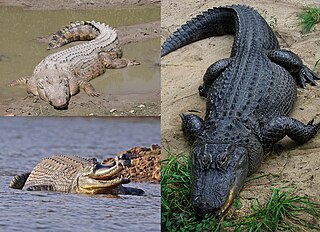
Crocodilia is an order of mostly large, predatory, semiaquatic reptiles known as crocodilians. They first appeared 94 million years ago in the Late Cretaceous period and are the closest living relatives of birds, as the two groups are the only known survivors of the Archosauria. Members of the order's total group, the clade Pseudosuchia, appeared about 250 million years ago in the Early Triassic period, and diversified during the Mesozoic era. The order Crocodilia includes the true crocodiles, the alligators and caimans, and the gharial and false gharial. Although the term crocodiles is sometimes used to refer to all of these, crocodilians is a less ambiguous vernacular term for members of this group.

The saltwater crocodile is a crocodilian native to saltwater habitats, brackish wetlands and freshwater rivers from India's east coast across Southeast Asia and the Sundaic region to northern Australia and Micronesia. It has been listed as Least Concern on the IUCN Red List since 1996. It was hunted for its skin throughout its range up to the 1970s, and is threatened by illegal killing and habitat loss. It is regarded as dangerous to humans.
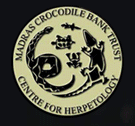
The Madras Crocodile Bank Trust and Centre for Herpetology (MCBT) is a reptile zoo and herpetology research station, located 40 kilometres (25 mi) south of the city of Chennai, in state of Tamil Nadu, India. The centre is both a registered trust and a recognized zoo under the Wildlife (Protection) Act, 1972 and comes under the purview of the Central Zoo Authority, Ministry of Environment, Forest and Climate Change, Government of India. It was established with the aim of saving three Indian endangered species of crocodile—the marsh or mugger crocodile, the saltwater crocodile, and the gharial, which at the time of founding of the trust were all nearing extinction.

The mugger crocodile is a medium-sized broad-snouted crocodile, also known as mugger and marsh crocodile. It is native to freshwater habitats from southern Iran to the Indian subcontinent, where it inhabits marshes, lakes, rivers and artificial ponds. It rarely reaches a body length of 5 m and is a powerful swimmer, but also walks on land in search of suitable waterbodies during the hot season. Both young and adult mugger crocodiles dig burrows to which they retreat when the ambient temperature drops below 5 °C (41 °F) or exceeds 38 °C (100 °F). Females dig holes in the sand as nesting sites and lay up to 46 eggs during the dry season. The sex of hatchlings depends on temperature during incubation. Both parents protect the young for up to one year. They feed on insects, and adults prey on fish, reptiles, birds and mammals.

The Nile crocodile is a large crocodilian native to freshwater habitats in Africa, where it is present in 26 countries. It is widely distributed in sub-Saharan Africa, occurring mostly in the eastern, southern, and central regions of the continent, and lives in different types of aquatic environments such as lakes, rivers, swamps, and marshlands. Although capable of living in saline environments, this species is rarely found in saltwater, but occasionally inhabits deltas and brackish lakes. The range of this species once stretched northward throughout the Nile River, as far north as the Nile Delta. Generally, the adult male Nile crocodile is between 3.5 and 5 m in length and weighs 225 to 750 kg. However, specimens exceeding 6.1 m (20 ft) in length and 1,000 kg (2,200 lb) in weight have been recorded. It is the largest freshwater predator in Africa, and may be considered the second-largest extant reptile in the world, after the saltwater crocodile. Size is sexually dimorphic, with females usually about 30% smaller than males. The crocodile has thick, scaly, heavily armoured skin.

The American crocodile is a species of crocodilian found in the Neotropics. It is the most widespread of the four extant species of crocodiles from the Americas, with populations present from South Florida and the coasts of Mexico to as far south as Peru, Ecuador, and Venezuela.

The freshwater crocodile, also known as the Australian freshwater crocodile, Johnstone's crocodile or the freshie, is a species of crocodile endemic to the northern regions of Australia. Unlike their much larger Australian relative, the saltwater crocodile, freshwater crocodiles are not known as man-eaters, although they bite in self-defence, and brief, nonfatal attacks have occurred, apparently the result of mistaken identity.

The Siamese crocodile is a medium-sized freshwater crocodile native to Indonesia, Brunei, East Malaysia, Laos, Cambodia, Myanmar, Thailand and Vietnam. The species is critically endangered and already extirpated from many regions. Its other common names include Siamese freshwater crocodile, Singapore small-grain, and soft-belly.
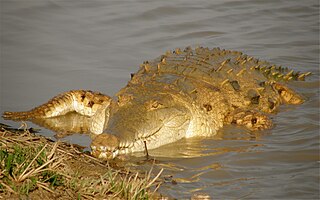
The Orinoco crocodile is a critically endangered crocodile. Its population is very small, and they can only be found in the Orinoco river basin in Venezuela and Colombia. Extensively hunted for their skins in the 19th and 20th centuries, it is one of the most endangered species of crocodiles. It is a very large species of crocodilian; males have been reported up to 6.8 m in the past, weighing over 900 kg (2,000 lb), but such sizes do not exist today, 5.2 m being a more widely accepted maximum size. A large male today may attain 4.2 m in length and can weigh up to 450 kg (1,000 lb), while females are substantially smaller with the largest likely to weigh around 225 kg (496 lb). Sexual dimorphism is not as profound as in other crocodilian species. The coloration is light even in adults.

The St. Augustine Alligator Farm Zoological Park is one of Florida's oldest continuously running attractions, having opened on May 20, 1893. It has 24 species of crocodilians, and also a variety of other reptiles, mammals and birds, as well as exhibits, animal performances and educational demonstrations.
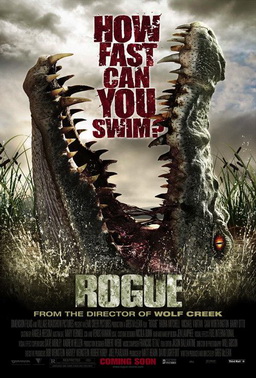
Rogue is a 2007 Australian independent horror film written, produced and directed by Greg McLean, about a group of tourists in Australia who fall prey to a giant, 25 ft (7.6 m) man-eating saltwater crocodile. It stars Michael Vartan, Sam Worthington and Radha Mitchell.

Morelet's crocodile, also known as the Mexican crocodile or Belize crocodile, is a modest-sized crocodilian found only in fresh waters of the Atlantic regions of Mexico, Belize and Guatemala. It usually grows to about 3 metres (10 ft) in length. It is a Least Concern species. The species has a fossil record in Guatemala.

Sweetheart was the name given to a 5.1 m (17 ft) male saltwater crocodile which Northern Territory folk legend claims was responsible for a series of attacks on boats in Australia in the 1970s.

Wildlife attacks in Australia occur every year from several different native species, including snakes, spiders, freshwater and saltwater crocodiles, various sharks, cassowaries, kangaroos, stingrays and stonefish and a variety of smaller marine creatures such as bluebottles, blue-ringed octopus, cone shells and jellyfish.

The Cuban crocodile is a small-medium species of crocodile endemic to Cuba. Typical length is 2.1–2.3 m (6.9–7.5 ft) and typical weight 70–80 kg (150–180 lb). Large males can reach as much as 3.5 m (11 ft) in length and weigh more than 215 kg (474 lb). Despite its smaller size, it is a highly aggressive animal, and potentially dangerous to humans.
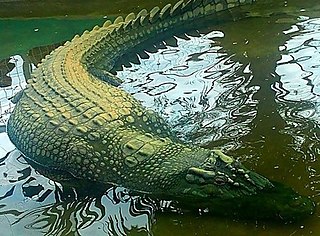
Lolong was the largest crocodile in captivity. He was a saltwater crocodile measured at 6.17 m, and weighed 1,075 kg (2,370 lb), making him one of the largest crocodiles ever measured from snout-to-tail.
Cassius is a male saltwater crocodile who was previously recognised by the Guinness World Records as the world's largest crocodile in captivity in 2011. The animal measures 5.48 metres in length, weighs approximately 1,300 kilograms (2,870 lb), and is kept at the Marineland Crocodile Park, a zoo on Green Island, Queensland, Australia.
CrocBITE was an online database of crocodile attacks reported on humans. The non-profit online research tool helped to scientifically analyze crocodile behavior via complex models. Users were encouraged to feed information in a crowdsourcing manner.

Crocodile skin either refers to the skin of a live crocodile or a leather made from dead crocodile hide. It has multiple applications across the fashion industry such as use for bags, shoes, and upholstery after being farmed and treated in specialist farms and tanneries.
{{cite web}}: CS1 maint: archived copy as title (link){{cite web}}: CS1 maint: unfit URL (link){{cite web}}: CS1 maint: numeric names: authors list (link)